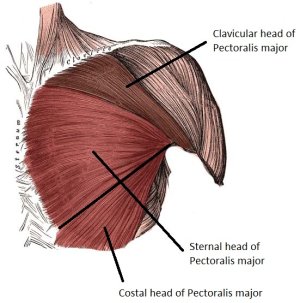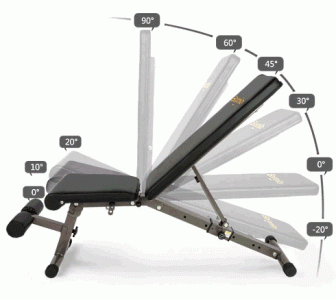MassMan
New member
A 30 degree incline was best for clavicular head or the upper pecs and 45-60 was best for deltoids. While the flat bench has been shown to activate both the clavicular head, the sternocostal head, and the costal portion, as the angle of inclination goes up, the sternocostal head involvement decreases and the clavicular head increases. Further inclination past 30 degrees and the clavicular head decreases while the involvement of the anterior deltoid increases. Yates claimed that by going 45 degrees to work anterior deltoids you are able to put a much higher load on the muscle as there is some involvement still by the clavicular head of the pecs. Of course any angle less that 30 degrees deactivates involvement in both the clavicular head, the sternocostal head and increases activation in the costal portion of the pecs. Of course the triceps are involved at any angle as an elbow extensor.

David Rodríguez-Ridao,José A. Antequera-Vique,Isabel Martín-Fuentes andJosé M. Muyor.
Effect of Five Bench Inclinations on the Electromyographic Activity of the Pectoralis Major, Anterior Deltoid, and Triceps Brachii during the Bench Press Exercise. Int. J. Environ. Res. Public Health 2020, 17(19), 7339; Effect of Five Bench Inclinations on the Electromyographic Activity of the Pectoralis Major, Anterior Deltoid, and Triceps Brachii during the Bench Press Exercise
Effect of Five Bench Inclinations on the Electromyographic Activity of the Pectoralis Major, Anterior Deltoid, and Triceps Brachii during the Bench Press Exercise
Abstract
The bench press exercise is one of the most used for training and for evaluating upper-body strength. The aim of the current study was to evaluate the electromyographic (EMG) activity levels of the pectoralis major (PM) in its three portions (upper portion, PMUP, middle portion, PMMP, and lower portion, PMLP), the anterior deltoid (AD), and the triceps brachii (TB) medial head during the bench press exercise at five bench angles (0°, 15°, 30°, 45°, and 60°). Thirty trained adults participated in the study. The EMG activity of the muscles was recorded at the aforementioned inclinations at 60% of one-repetition maximum (1RM). The results showed that the maximal EMG activity for PMUP occurred at a bench inclination of 30°. PMMP and PMLP showed higher EMG activity at a 0° bench inclination. AD had the highest EMG activity at 60°. TB showed similar EMG activities at all bench inclinations.
In conclusion, the horizontal bench press produces similar electromyographic activities for the pectoralis major and the anterior deltoid. An inclination of 30° produces greater activation of the upper portion of the pectoralis major. Inclinations greater than 45° produce significantly higher activation of the anterior deltoid and decrease the muscular performance of the pectoralis major.


David Rodríguez-Ridao,José A. Antequera-Vique,Isabel Martín-Fuentes andJosé M. Muyor.
Effect of Five Bench Inclinations on the Electromyographic Activity of the Pectoralis Major, Anterior Deltoid, and Triceps Brachii during the Bench Press Exercise. Int. J. Environ. Res. Public Health 2020, 17(19), 7339; Effect of Five Bench Inclinations on the Electromyographic Activity of the Pectoralis Major, Anterior Deltoid, and Triceps Brachii during the Bench Press Exercise
Effect of Five Bench Inclinations on the Electromyographic Activity of the Pectoralis Major, Anterior Deltoid, and Triceps Brachii during the Bench Press Exercise
Abstract
The bench press exercise is one of the most used for training and for evaluating upper-body strength. The aim of the current study was to evaluate the electromyographic (EMG) activity levels of the pectoralis major (PM) in its three portions (upper portion, PMUP, middle portion, PMMP, and lower portion, PMLP), the anterior deltoid (AD), and the triceps brachii (TB) medial head during the bench press exercise at five bench angles (0°, 15°, 30°, 45°, and 60°). Thirty trained adults participated in the study. The EMG activity of the muscles was recorded at the aforementioned inclinations at 60% of one-repetition maximum (1RM). The results showed that the maximal EMG activity for PMUP occurred at a bench inclination of 30°. PMMP and PMLP showed higher EMG activity at a 0° bench inclination. AD had the highest EMG activity at 60°. TB showed similar EMG activities at all bench inclinations.
In conclusion, the horizontal bench press produces similar electromyographic activities for the pectoralis major and the anterior deltoid. An inclination of 30° produces greater activation of the upper portion of the pectoralis major. Inclinations greater than 45° produce significantly higher activation of the anterior deltoid and decrease the muscular performance of the pectoralis major.

